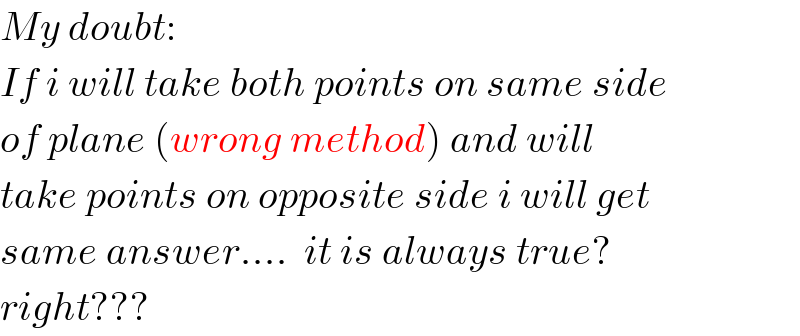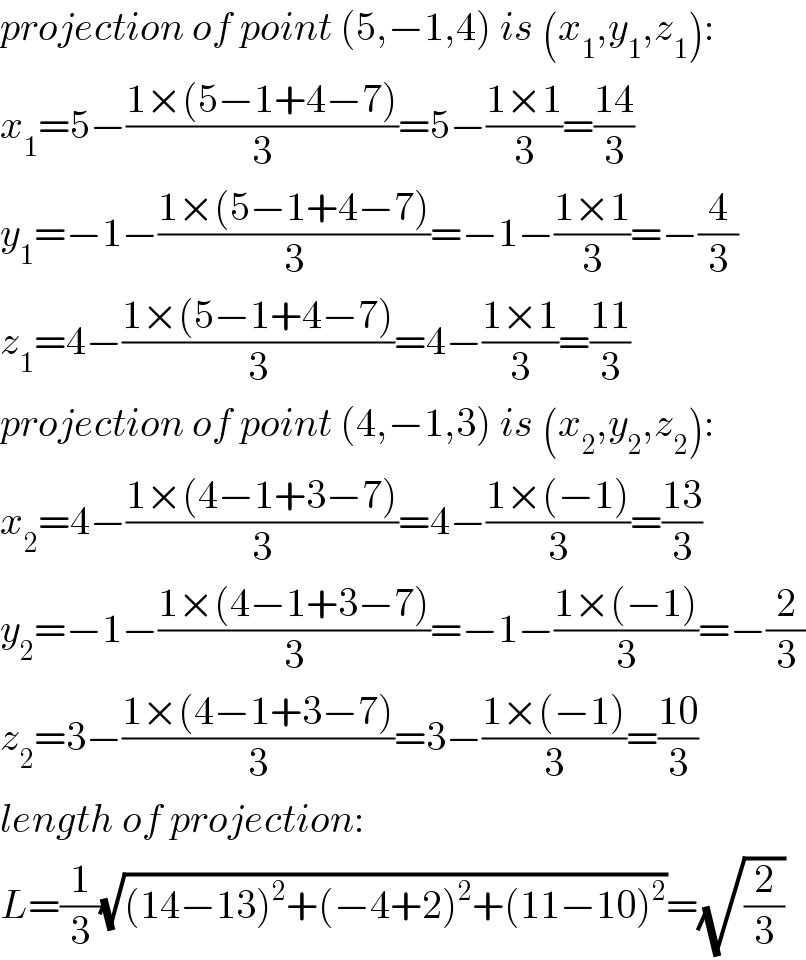Question Number 45575 by rahul 19 last updated on 14/Oct/18

Commented by rahul 19 last updated on 14/Oct/18

$${My}\:{doubt}: \\ $$$${If}\:{i}\:{will}\:{take}\:{both}\:{points}\:{on}\:{same}\:{side} \\ $$$${of}\:{plane}\:\left({wrong}\:{method}\right)\:{and}\:{will} \\ $$$${take}\:{points}\:{on}\:{opposite}\:{side}\:{i}\:{will}\:{get}\: \\ $$$${same}\:{answer}….\:\:{it}\:{is}\:{always}\:{true}? \\ $$$${right}??? \\ $$
Commented by MrW3 last updated on 14/Oct/18

Commented by MrW3 last updated on 14/Oct/18

$${projection}\:{of}\:{P}_{\mathrm{1}} {P}_{\mathrm{2}} \:{and}\:{P}_{\mathrm{1}} {P}_{\mathrm{2}} '\:{is}\:{the}\:{same}, \\ $$$${i}.{e}.\:{Q}_{\mathrm{1}} {Q}_{\mathrm{2}.} \\ $$
Commented by rahul 19 last updated on 14/Oct/18

$${thanks}\:{sir}! \\ $$
Answered by MrW3 last updated on 14/Oct/18

$${projection}\:{of}\:{point}\:\left(\mathrm{5},−\mathrm{1},\mathrm{4}\right)\:{is}\:\left({x}_{\mathrm{1}} ,{y}_{\mathrm{1}} ,{z}_{\mathrm{1}} \right): \\ $$$${x}_{\mathrm{1}} =\mathrm{5}−\frac{\mathrm{1}×\left(\mathrm{5}−\mathrm{1}+\mathrm{4}−\mathrm{7}\right)}{\mathrm{3}}=\mathrm{5}−\frac{\mathrm{1}×\mathrm{1}}{\mathrm{3}}=\frac{\mathrm{14}}{\mathrm{3}} \\ $$$${y}_{\mathrm{1}} =−\mathrm{1}−\frac{\mathrm{1}×\left(\mathrm{5}−\mathrm{1}+\mathrm{4}−\mathrm{7}\right)}{\mathrm{3}}=−\mathrm{1}−\frac{\mathrm{1}×\mathrm{1}}{\mathrm{3}}=−\frac{\mathrm{4}}{\mathrm{3}} \\ $$$${z}_{\mathrm{1}} =\mathrm{4}−\frac{\mathrm{1}×\left(\mathrm{5}−\mathrm{1}+\mathrm{4}−\mathrm{7}\right)}{\mathrm{3}}=\mathrm{4}−\frac{\mathrm{1}×\mathrm{1}}{\mathrm{3}}=\frac{\mathrm{11}}{\mathrm{3}} \\ $$$${projection}\:{of}\:{point}\:\left(\mathrm{4},−\mathrm{1},\mathrm{3}\right)\:{is}\:\left({x}_{\mathrm{2}} ,{y}_{\mathrm{2}} ,{z}_{\mathrm{2}} \right): \\ $$$${x}_{\mathrm{2}} =\mathrm{4}−\frac{\mathrm{1}×\left(\mathrm{4}−\mathrm{1}+\mathrm{3}−\mathrm{7}\right)}{\mathrm{3}}=\mathrm{4}−\frac{\mathrm{1}×\left(−\mathrm{1}\right)}{\mathrm{3}}=\frac{\mathrm{13}}{\mathrm{3}} \\ $$$${y}_{\mathrm{2}} =−\mathrm{1}−\frac{\mathrm{1}×\left(\mathrm{4}−\mathrm{1}+\mathrm{3}−\mathrm{7}\right)}{\mathrm{3}}=−\mathrm{1}−\frac{\mathrm{1}×\left(−\mathrm{1}\right)}{\mathrm{3}}=−\frac{\mathrm{2}}{\mathrm{3}} \\ $$$${z}_{\mathrm{2}} =\mathrm{3}−\frac{\mathrm{1}×\left(\mathrm{4}−\mathrm{1}+\mathrm{3}−\mathrm{7}\right)}{\mathrm{3}}=\mathrm{3}−\frac{\mathrm{1}×\left(−\mathrm{1}\right)}{\mathrm{3}}=\frac{\mathrm{10}}{\mathrm{3}} \\ $$$${length}\:{of}\:{projection}: \\ $$$${L}=\frac{\mathrm{1}}{\mathrm{3}}\sqrt{\left(\mathrm{14}−\mathrm{13}\right)^{\mathrm{2}} +\left(−\mathrm{4}+\mathrm{2}\right)^{\mathrm{2}} +\left(\mathrm{11}−\mathrm{10}\right)^{\mathrm{2}} }=\sqrt{\frac{\mathrm{2}}{\mathrm{3}}} \\ $$
Answered by tanmay.chaudhury50@gmail.com last updated on 14/Oct/18

$${distance}\:{between}\:\left(\mathrm{5},−\mathrm{1},\mathrm{4}\right)\:{and}\:\left(\mathrm{4},−\mathrm{1},\mathrm{3}\right) \\ $$$$\sqrt{\left(\mathrm{5}−\mathrm{4}\right)^{\mathrm{2}} +\left(−\mathrm{1}+\mathrm{1}\right)^{\mathrm{2}} +\left(\mathrm{4}−\mathrm{3}\right)^{\mathrm{2}} }\:=\sqrt{\mathrm{2}}\: \\ $$$${the}\:{st}\:{line}\:{joining}\:\left(\mathrm{5},−\mathrm{1},\mathrm{4}\right)\:{and}\left(\mathrm{4},−\mathrm{1},\mathrm{3}\right) \\ $$$$\frac{{x}−\mathrm{5}}{\mathrm{4}−\mathrm{5}}=\frac{{y}+\mathrm{1}}{\mathrm{0}}=\frac{{z}−\mathrm{4}}{\mathrm{3}−\mathrm{4}}=\rightarrow\frac{{x}−\mathrm{5}}{\mathrm{1}}=\frac{{y}+\mathrm{1}}{\mathrm{0}}=\frac{{z}−\mathrm{4}}{\mathrm{1}} \\ $$$${angle}\:{between}\:{normsl}\:{to}\:{the}\:{plane}\:{and}\:{the}\:{st} \\ $$$${line}\:{cos}\theta=\frac{\mathrm{1}×\mathrm{1}+\mathrm{0}×\mathrm{1}+\mathrm{1}×\mathrm{1}}{\:\sqrt{\mathrm{1}^{\mathrm{2}} +\mathrm{1}^{\mathrm{2}} +\mathrm{1}^{\mathrm{2}} }\:\:×\sqrt{\mathrm{1}^{\mathrm{2}} +{o}^{\mathrm{2}} +\mathrm{1}^{\mathrm{2}} }}\:=\frac{\mathrm{2}}{\:\sqrt{\mathrm{3}}\:×\sqrt{\mathrm{2}}\:} \\ $$$${sin}\theta=\frac{\sqrt{\mathrm{2}}}{\:\sqrt{\mathrm{6}}\:} \\ $$$${projection}={p} \\ $$$${sin}\theta=\frac{{p}}{{d}}\:\:\:{p}={dsin}\theta=\sqrt{\mathrm{2}}\:×\frac{\sqrt{\mathrm{2}}}{\:\sqrt{\mathrm{6}}}=\frac{\sqrt{\mathrm{2}}}{\:\sqrt{\mathrm{3}}} \\ $$
